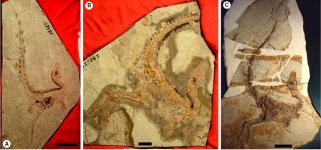Fred Ruhe
Well-known member

Fiann M. Smithwick, Gerald Mayr, Evan T. Saitta, Michael J. Benton & Jakob Vinther, 2017
On the purported presence of fossilized collagen fibres in an ichthyosaur and a theropod dinosaur
Palaeontology Volume 60, Issue 3 May 2017 Pages 409–422
Abstract:
Since the discovery of exceptionally preserved theropod dinosaurs with soft tissues in China in the 1990s, there has been much debate about the nature of filamentous structures observed in some specimens. Sinosauropteryx was the first non-avian theropod to be described with these structures, and remains one of the most studied examples. Despite a general consensus that the structures represent feathers or feather homologues, a few identify them as degraded collagen fibres derived from the skin. This latter view has been based on observations of low-quality images of Sinosauropteryx, as well as the suggestion that because superficially similar structures are seen in Jurassic ichthyosaurs they cannot represent feathers. Here, we highlight issues with the evidence put forward in support of this view, showing that integumentary structures have been misinterpreted based on sedimentary features and preparation marks, and that these errors have led to incorrect conclusions being drawn about the existence of collagen in Sinosauropteryx and the ichthyosaur Stenopterygius. We find that there is no evidence to support the idea that the integumentary structures seen in the two taxa are collagen fibres, and confirm that the most parsimonious interpretation of fossilized structures that look like feather homologues in Sinosauropteryx is that they are indeed the remains of feather homologues.
Free pdf: http://onlinelibrary.wiley.com/doi/10.1111/pala.12292/epdf
Enjoy,
Fred
The three best preserved described specimens of Sinosauropteryx from the Early Cretaceous Jehol Biota of Liaoning Province, China. All three specimens show the preservation of integumentary structures identified by some as feathers, and others as degraded collagen fibres. The integument can be seen as the dark brown patches across the dorsum and tail. A, NIGP 127586; counterpart of the holotype. B, NIGP 127587. C, IVPP V12415; orange staining present across the matrix is probably due to the presence of iron oxides, and is different from the clearly darker colour of the ntegument. Scale bars represent: 50 mm in (A, B); and 100 mm (C).
On the purported presence of fossilized collagen fibres in an ichthyosaur and a theropod dinosaur
Palaeontology Volume 60, Issue 3 May 2017 Pages 409–422
Abstract:
Since the discovery of exceptionally preserved theropod dinosaurs with soft tissues in China in the 1990s, there has been much debate about the nature of filamentous structures observed in some specimens. Sinosauropteryx was the first non-avian theropod to be described with these structures, and remains one of the most studied examples. Despite a general consensus that the structures represent feathers or feather homologues, a few identify them as degraded collagen fibres derived from the skin. This latter view has been based on observations of low-quality images of Sinosauropteryx, as well as the suggestion that because superficially similar structures are seen in Jurassic ichthyosaurs they cannot represent feathers. Here, we highlight issues with the evidence put forward in support of this view, showing that integumentary structures have been misinterpreted based on sedimentary features and preparation marks, and that these errors have led to incorrect conclusions being drawn about the existence of collagen in Sinosauropteryx and the ichthyosaur Stenopterygius. We find that there is no evidence to support the idea that the integumentary structures seen in the two taxa are collagen fibres, and confirm that the most parsimonious interpretation of fossilized structures that look like feather homologues in Sinosauropteryx is that they are indeed the remains of feather homologues.
Free pdf: http://onlinelibrary.wiley.com/doi/10.1111/pala.12292/epdf
Enjoy,
Fred
The three best preserved described specimens of Sinosauropteryx from the Early Cretaceous Jehol Biota of Liaoning Province, China. All three specimens show the preservation of integumentary structures identified by some as feathers, and others as degraded collagen fibres. The integument can be seen as the dark brown patches across the dorsum and tail. A, NIGP 127586; counterpart of the holotype. B, NIGP 127587. C, IVPP V12415; orange staining present across the matrix is probably due to the presence of iron oxides, and is different from the clearly darker colour of the ntegument. Scale bars represent: 50 mm in (A, B); and 100 mm (C).






